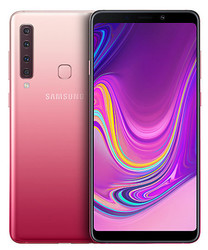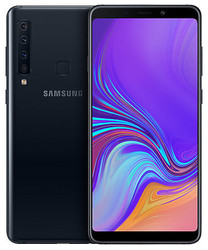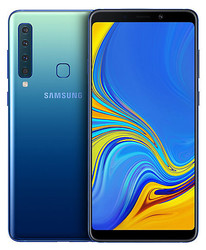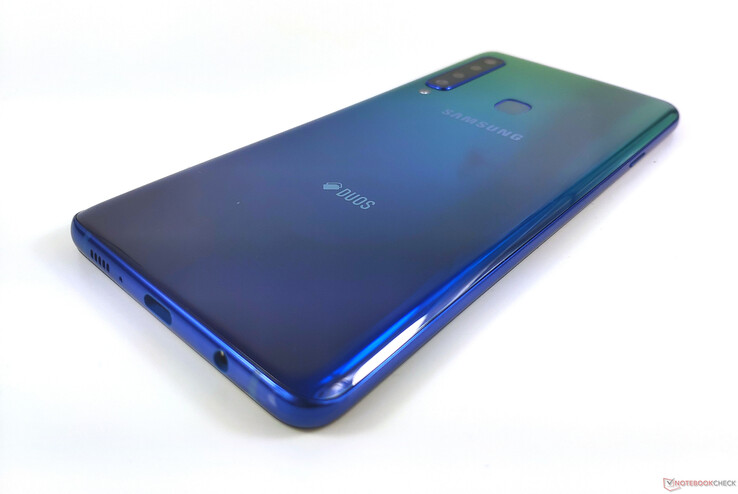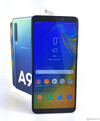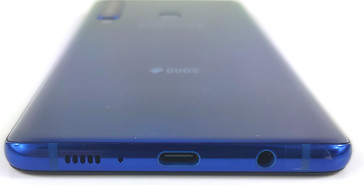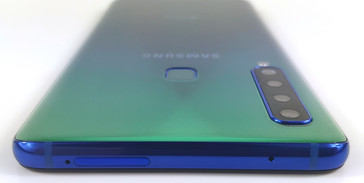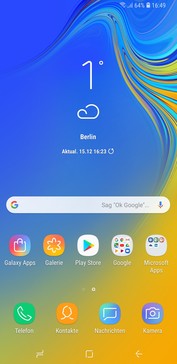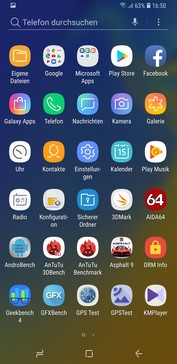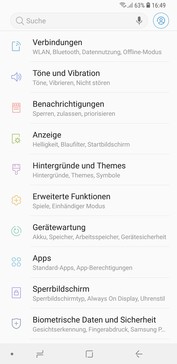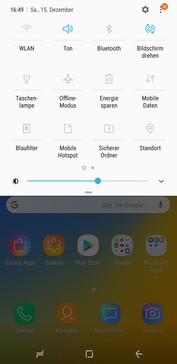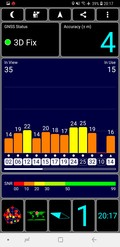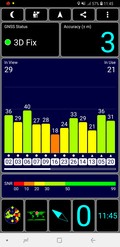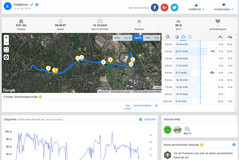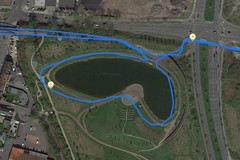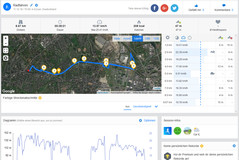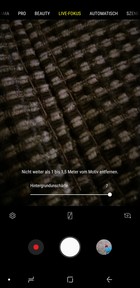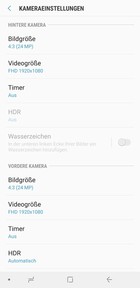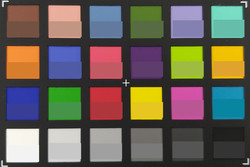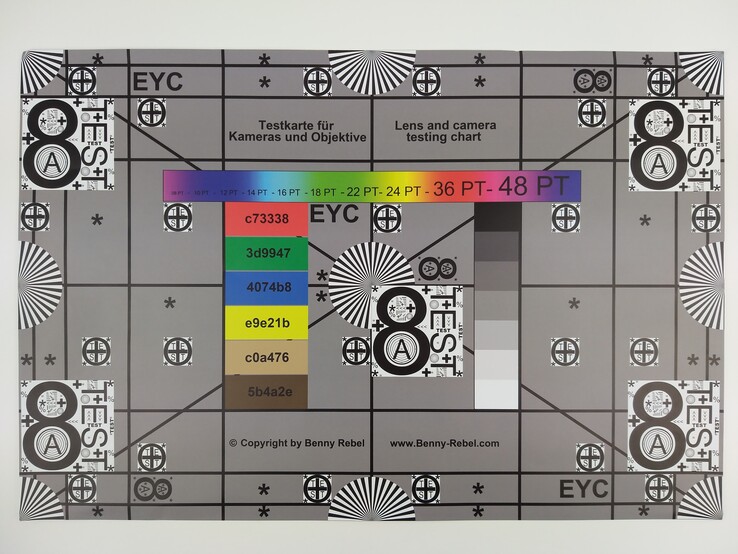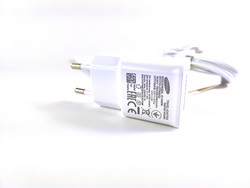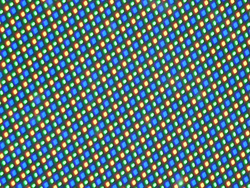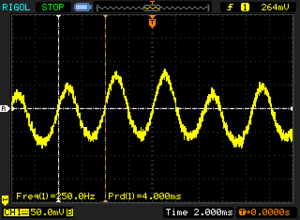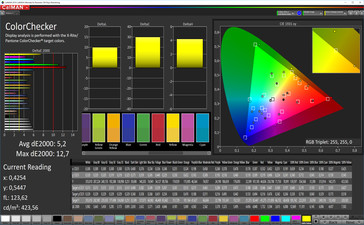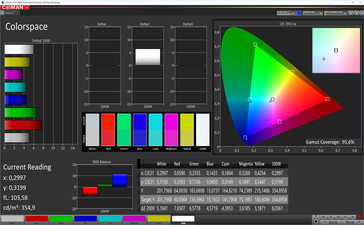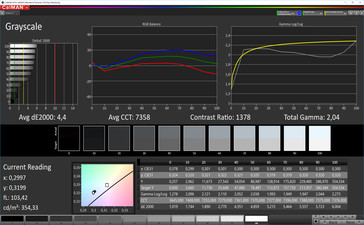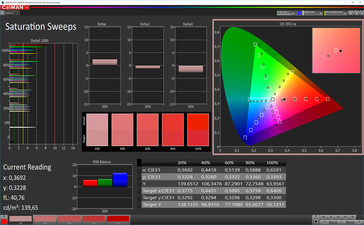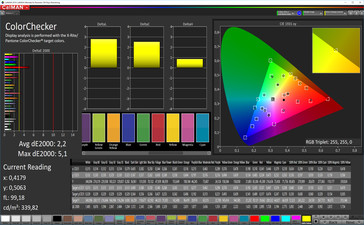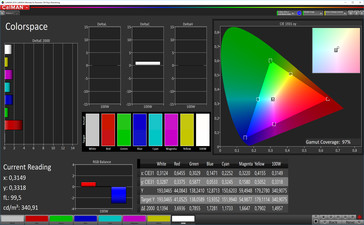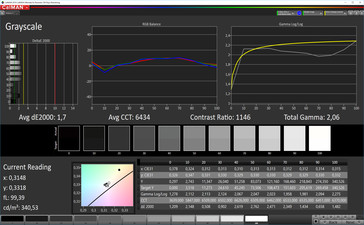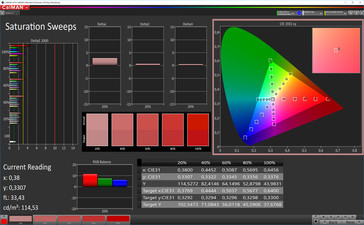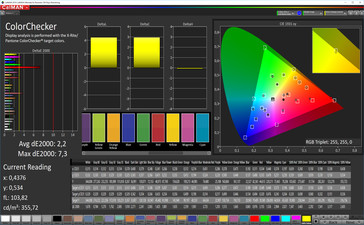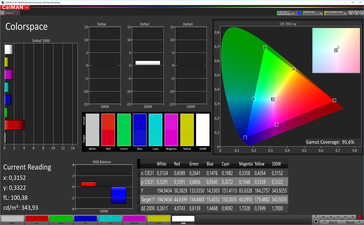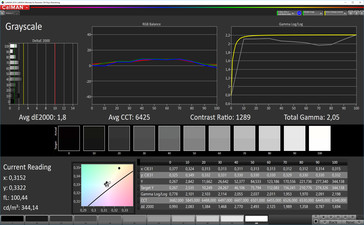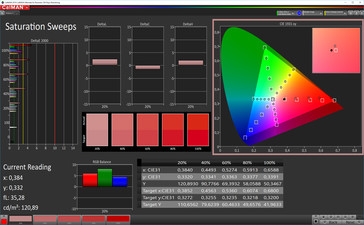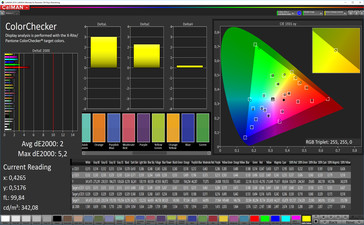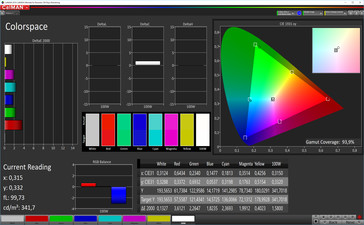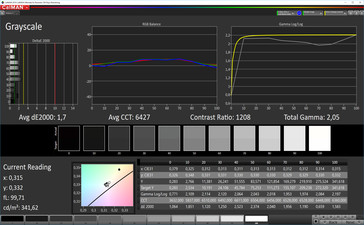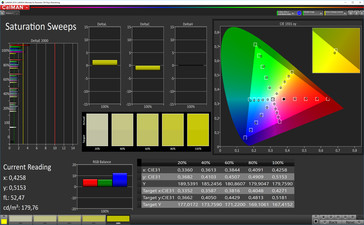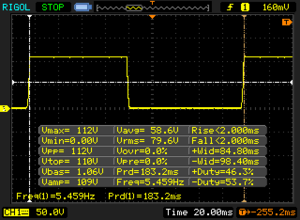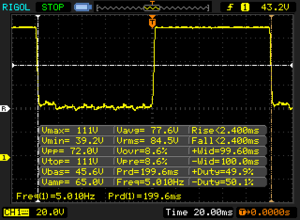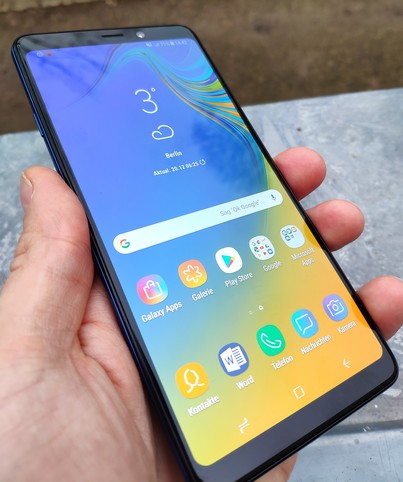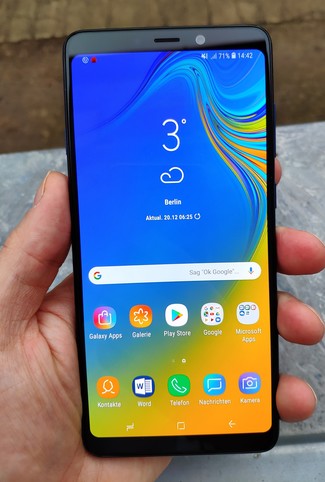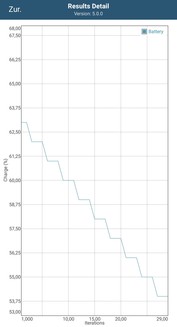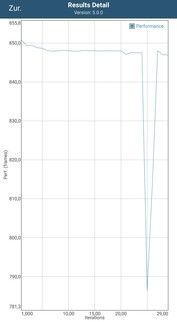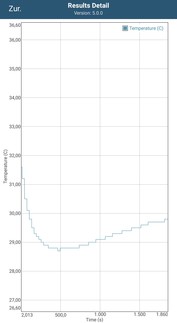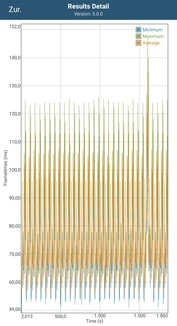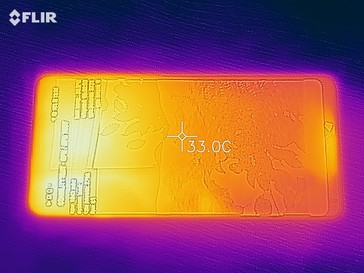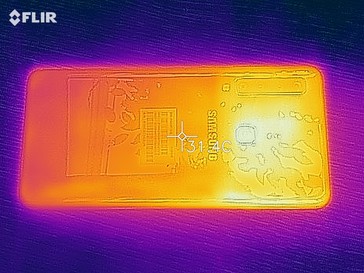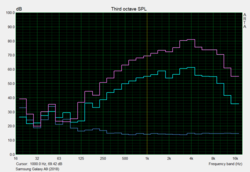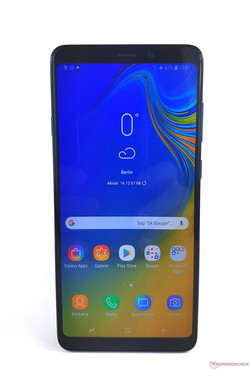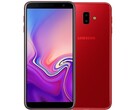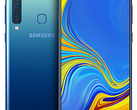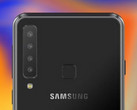Samsung Galaxy A9 (2018) Smartphone Review
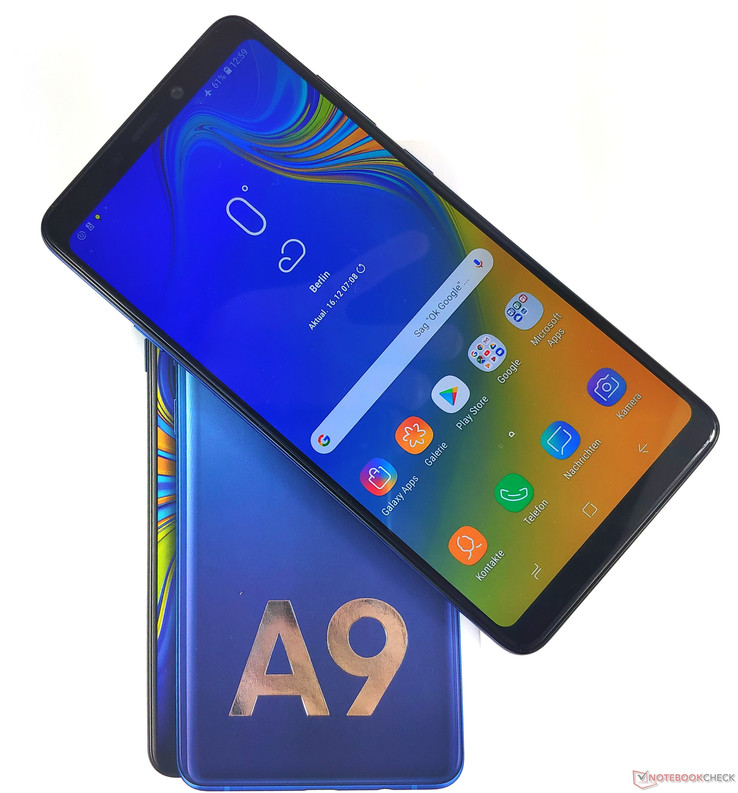
Samsung advertises the newest family member in the Galaxy A series as the first smartphone in the world with a main quad-camera. We are not aware of any competing product with more rear-facing cameras—with the exceptions of the multi-camera concepts for the Nokia 9 and the Light Phone, which at this point are no more than rumors.
With the Galaxy A9 (2018), the Korean manufacturer is offering users one primary thing: Maximum flexibility when taking photos and videos. The Samsung smartphone provides a plethora of camera options with its four camera lenses and three different focal lengths—not to mention its intelligent photo-editing and scene optimization, enabling the camera to identify different subjects.
The 6.3-inch phone's internal specs are more appropriate to a mid-range smartphone than Samsung's projected recommended retail price of around 600 Euros (~$680). The Galaxy A9 (2018) runs on one of last year's 600-series Snapdragon CPUs, not one of Qualcomm's current high-performance chips. The Snapdragon 660 is accompanied by 6 GB of RAM and 128 GB of internal storage. Users who desire more space for photos, music or videos can expand the internal storage via microSD card by up to 512 GB.
In addition to Samsung's own organic Super AMOLED panel with a resolution of 2220x1080 pixels, the Galaxy A9 (2018) offers a 3800 mAh battery and modern connectivity standards such as Bluetooth 5.0 and NFC. A visual highlight of the Samsung smartphone is its glass back, which is accentuated by a striking color gradient (similar to Huawei's "twilight" finish).
The Samsung Galaxy A9 (2018), available in Germany since November, is currently selling at a street price of around 480 Euros (~$550; international version ~$525). Competition is especially intense in the mid-range price bracket (~350-500 Euros), leaving us with a very long list of potential competitors. Ultimately, we chose the following as our devices for comparison: the Nokia 7 Plus, Xiaomi Pocophone F1, BQ Aquaris X2 Pro and the OnePlus 6T. In terms of price, the Samsung smartphone is situated somewhat below the elite smartphones introduced at the beginning of 2018: the Huawei P20 and Samsung Galaxy S9 (256 GB version).
Case - Back side of Samsung phone with attractive color gradient
The outer appearance of the Galaxy A9 (2018) is very similar to that of the Samsung Galaxy A7 (2018) we recently reviewed. The front side of the case consists of scratch-resistant 2.5D display glass, which has a slight curvature and protrudes minimally from the 8 millimeter-wide metal frame. The 6.3-inch OLED panel's bezel is very narrow on the sides—not so above and below the display. As a result, the proportion of the display size compared to the front of the device is only around 79%. For comparison, the almost bezel-less Xiaomi Mi Mix 3 manages a ratio of over 85%.
The case's good manufacturing quality is an attractive feature. The Galaxy A9 (2018) offers no specified protection against dust or water. The curving edges on the phone's glass back and its slim build make the Samsung smartphone feel very good in your hand. On our test device, however, there is a small transition space between the glass and the frame that feels somewhat sharp-edged. The quad-camera on the back protrudes minimally. The fingerprint reader is also located on the back, adjacent to the camera element. The reader does not sit perfectly in the case and jiggles a little when pressed hard.
The color gradient is aesthetically pleasing, flowing smoothly from a dark tone on the lower third of the case into successively lighter colors. The color options include Lemonade Blue (a blue-green) and Bubblegum Pink. For those who prefer a more discreet look, the Galaxy A9 (2018) is also available in Caviar Black.
The card slot on the top of the case sits flush with the frame and is made of plastic. This slot can house up to two nano-SIM cards, as well as an additional microSD card. The physical keys are also made of plastic, are well-manufactured and they are well-situated. As is typical for a Samsung device, the left side of the case houses an AI button for the Bixby virtual assistant. This cannot be customized in the settings menu.
Connectivity - 128 GB UFS storage on board the Galaxy A9
Connectivity features of the Samsung smartphone include a USB Type-C 2.0 port, a compass, a 3.5 mm jack and an Always On display. The latter can display the date, weather, time and incoming messages. In addition, the Galaxy A9 (2018) has a fingerprint reader and is equipped with face-recognition technology for unlocking the device.
The phone also supports wireless transfer of display content to an external monitor via Miracast. In our test with a Sony Android TV, this feature functioned well. An MHL port for the transfer of high-resolution audio and video material to an external display is not on board.
The internal UFS storage in our test device has a capacity of 128 GB, though the user is only left with 109 GB of free space in factory default. Users who need more space can expand the storage with a microSD card, though it cannot be formatted to internal storage. The exFAT file system is supported. According to the manufacturer's specs, the microSD card slot supports storage media up to 512 GB in size. Even with expanded storage, users of the Galaxy A9 (2018) can still use two SIM cards simultaneously. With an OTG adapter, peripheral equipment like USB sticks can be connected to the phone via the USB port.
Software - Galaxy A9 with Android 8.0
As of the publish date of this review, the Galaxy A9 (2018) comes with Google's Android 8.0 Oreo. The security update is dated from October 2018. The Korean manufacturer chose to overlay the Google user interface with its proprietary Experience UI version 9.0.
The Samsung user interface is greatly modified compared to Android Vanilla and has little in common with the pure Google version. In addition to having a very different look, the system software offers numerous customization options. The OS comes with bloatware that cannot be uninstalled.
It is very likely that the software will be updated to the current version of Android (9.0), but users will probably have to wait until the middle of next year. Whether the operating system upgrade will include the upcoming One UI user interface also remains to be seen. So far, no official statements have been made.
Communication and GPS - Samsung smartphone with NFC
Thanks to LTE Cat. 9, the Samsung smartphone can access the Internet with download speeds of up to 450 Mb/s. In total, the Galaxy A9 (2018) supports 17 LTE bands, five UMTS frequencies and quad-band GSM. As a result, the built-in wireless modem covers all the LTE frequencies that are relevant for Germany—including LTE band 28, which will be increasingly important in the future.
In terms of communication modules, Samsung selected Bluetooth 5.0, the current version. An NFC chip is also available for near-field communication, enabling users of the mid-range smartphone to make purchases at brick-and-mortar stores via Google Pay.
The Galaxy A9 (2018)'s integrated WLAN module supports the IEEE 802.11 standards a/b/g/n/ac and transmits not only on the 2.4 GHz band but also in the 5 GHz frequency range. In everyday use, the WLAN module's reception is good and the signal is stable. In the immediate vicinity of the router (Telekom Speedport, W921V), we measured a signal attenuation of -37 dBm.
The WLAN module's support for MIMO antenna technology enables the smartphone to achieve high and constant data transfer rates on home networks—at least when it comes to reception. Together with our Linksys EA8500 reference router, the Samsung phone reached transfer rates of 584 Mb/s. At an average of 285 Mb/s, the send rates drop off significantly.
The dual SIM device offers space for two nano-SIM cards. Neither of the two card slots is limited in terms of supported frequencies. Even when two SIM cards are in use, a microSD card can be inserted for memory expansion.
Location services function by means of the main satellite systems: GPS, GLONASS, Galileo, Beidou and the SBAS satellite-based augmentation system. The first satellite fix outdoors occurs quickly, and the smartphone ascertains its position with an accuracy of around three meters (~10 feet). Even indoors, the Galaxy A9 (2018) positions itself quite quickly, though only with an accuracy of four meters.
In order to determine the location accuracy of our test device in everyday use, we take it on a bike ride with a Garmin Edge 500 GPS bike navigation system and compare the results. At the end of our 9 kilometer-long route (~5.6 miles), the paths recorded by the Samsung phone and the professional navigation device differ by around 140 meters (~460 feet).
The GPS module in the Galaxy A9 (2018) only diverges slightly from that of the Garmin Edge, and considering the details of the route recorded by the GPS, the mid-range smartphone's location accuracy is good enough to qualify the phone for use as a car navigation system.
Phone Function and Speech Quality - VoLTE and WLAN calls on board
The Samsung smartphone supports modern standards, such as VoLTE and WLAN calls. The call quality is good. We did not experience any dropped calls or other reception problems with the Galaxy A9 (2018) in our tests. The voice of the person on the other end is rendered clearly, and our conversation partner characterized our voice as cleanly transmitted as well. In a video call with the Skype app we installed, the built-in microphones provided good speech quality.
Alongside a speed-dial function, the telephone app offers direct access to call lists, saved contacts and nearby venues.
Cameras - Quad-cam & good selfie camera
The Samsung phone's back camera is equipped with four lenses. The main camera module has a resolution of 24 MP with a fast lens speed of f/1.7. This lens is joined by a 120 ° ultra wide-angle camera with an aperture of f/2.4 and 8 MP designed to capture faraway objects, as well as a 10 MP telephoto lens with an aperture of f/2.4 for lossless 2x zoom. Thanks to the fourth lens, which has a resolution of 5 MP and an f/2.2 aperture, the level of background blur can be manipulated in photos taken by the smartphone. The Galaxy A9 (2018)'s live focus function makes it possible to blur a subject's background. The intensity of the background blur can be changed while taking a photo and after it has already been shot. The quality of the Samsung phone's bokeh effect is fairly impressive. Artifacts do show up in the images, but for the most part the blur transitions are quite well-executed.
Photos captured by the 24 MP main camera in daylight offer a high level of detail and good color reproduction, but the high recommended retail price of the mid-range smartphone is in no way reflected in the photo quality. Compared to photos taken with a Google Pixel 3—or, with some limitations, a OnePlus 6T—the Galaxy A9 (2018)'s shots are substantially inferior in the realms of sharpness and dynamics. In low light, the pictures are plagued by clearly visible image noise and the level of blurriness rises. The level of brightness captured in the photos, on the other hand, is very good. The Galaxy A9 (2018) score points here, thanks to the main camera's fast lens.
Moving away from the center of the photo, the 120 ° lens has the typical curvature of ultra wide-angle cameras. It captures less light and fewer details. Especially in dark environments, the photo quality compared to the main camera is visibly inferior.
The 24 MP front camera captures very good selfies. With an aperture of f/2.0, this lens is slower than the main camera, but this is only noticeable to a limited extent in poor lighting conditions. Even in increasingly dark environments, photos appear well-lit and sharp. As is very common for front cameras, the Samsung phone's shots tend to be overexposed. The front camera records videos in FHD resolution (1920x1080 pixels) at up to 30 frames per second. The main camera on the back side captures moving pictures in a maximum of UHD resolution (3840x2160 pixels) at 30 fps.
We examined the Galaxy A smartphone's color reproduction in a controlled lighting environment. Compared to the actual reference hues, the mid-range phone's colors are somewhat lighter but otherwise well-matched. The 24 MP main camera's shots of the X-Rite ColorChecker Passport (without post-processing, ex. manual white balance) reveal good color accuracy. White tones are somewhat too warm.
In order to judge the sharpness of the shots, we photograph our test chart in a controlled lighting environment as well. The image sharpness of the photos is very good. Even along the edges of the shots, the blurriness is not excessive.
Accessories and Warranty - Samsung phone without many surprises
The Galaxy A9 (2018)'s box contents include a modular 15-watt power supply (9V, 1.67 A), a USB cable and in-ear headphones.
The Samsung smartphone's manufacturer's warranty lasts 24 months from the date of purchase. Please see our Guarantees, Return policies and Warranties article for country-specific information.
Input Devices and Operation - Galaxy A9 with Face Unlock function
The phone can be operated either via the Android on-screen "back", "multitasking" and "home" keys, or via gestures. The capacitive touchscreen is very sensitive and can be operated with precision even in the corners, and it has a smooth surface that fingers easily glide across.
An active fingerprint reader is located on the back. This reader is not one of the fastest sensors on the market, but it unlocks the mid-range smartphone reliably. The phone also offers biometric identification via face recognition. The Face Unlock function through the front camera also reliably unlocks the Galaxy A9 (2018) in poor lighting conditions, though not particularly quickly.
Display - Attractive OLED panel in the Samsung smartphone
The Galaxy A9 (2018) is equipped with a 6.3-inch (15.95 cm) AMOLED display in 18.5:9 format with a resolution of 2220x1080 pixels. The resulting pixel density of somewhat less than 400 PPI is perfectly adequate in everyday use, even if some of the competitors' QHD displays offer substantially higher image sharpness.
In terms of brightness, the mid-range smartphone has a lot to offer. In automatic mode and with the ambient light sensor activated, with a pure white background we measured a maximum of 560 cd/m² in the center of the display. In our more realistic APL50 measurement, which simulates everyday conditions with evenly distributed light and dark areas in all portions of the screen, the result was 716 cd/m². If the brightness sensor is deactivated, the Galaxy A9 (2018) reaches just 347 cd/m².
Since organic light-emitting diodes almost never glow at their theoretical maximum brightness, the Galaxy A9 (2018)'s light density is also reduced. This task is covered by pulse width modulation, or PWM for short. PWM regulates brightness in the Samsung phone at a frequency of 250 Hz. Subjectively, we did not discover any bothersome flickering, but PWM can cause problems like headaches or dizziness for sensitive users—especially at low frequencies such as that of the Samsung phone.
| |||||||||||||||||||||||||
Brightness Distribution: 96 %
Center on Battery: 553 cd/m²
Contrast: ∞:1 (Black: 0 cd/m²)
ΔE ColorChecker Calman: 2.2 | ∀{0.5-29.43 Ø4.78}
ΔE Greyscale Calman: 1.7 | ∀{0.09-98 Ø5}
97% sRGB (Calman 2D)
Gamma: 2.06
CCT: 6434 K
| Samsung Galaxy A9 2018 OLED, 2220x1080, 6.3" | Xiaomi Poco F1 IPS, 2246x1080, 6.2" | OnePlus 6T Optic AMOLED, 2340x1080, 6.4" | Samsung Galaxy S9 Super AMOLED, 2960x1440, 5.8" | Huawei P20 LTPS, 2240x1080, 5.8" | LG G7 ThinQ IPS, 3120x1440, 6.1" | BQ Aquaris X2 Pro LTPS, 2160x1080, 5.7" | Nokia 7 Plus IPS, 2160x1080, 6" | |
|---|---|---|---|---|---|---|---|---|
| Screen | -50% | -8% | 9% | 28% | -57% | -84% | -57% | |
| Brightness middle (cd/m²) | 553 | 489 -12% | 437 -21% | 529 -4% | 753 36% | 974 76% | 675 22% | 458 -17% |
| Brightness (cd/m²) | 553 | 486 -12% | 442 -20% | 527 -5% | 748 35% | 975 76% | 650 18% | 463 -16% |
| Brightness Distribution (%) | 96 | 93 -3% | 95 -1% | 96 0% | 96 0% | 96 0% | 92 -4% | 92 -4% |
| Black Level * (cd/m²) | 0.34 | 0.37 | 0.49 | 0.46 | 0.22 | |||
| Colorchecker dE 2000 * | 2.2 | 3.8 -73% | 2.21 -0% | 1.4 36% | 1.3 41% | 5.4 -145% | 5.9 -168% | 4 -82% |
| Colorchecker dE 2000 max. * | 5.1 | 7.1 -39% | 4.27 16% | 4 22% | 2.3 55% | 13.1 -157% | 9.5 -86% | 7.4 -45% |
| Greyscale dE 2000 * | 1.7 | 4.4 -159% | 2.1 -24% | 1.6 6% | 1.7 -0% | 5 -194% | 6.6 -288% | 4.7 -176% |
| Gamma | 2.06 107% | 2.22 99% | 2.307 95% | 2.16 102% | 2.18 101% | 2.31 95% | 2.36 93% | 2.19 100% |
| CCT | 6434 101% | 7213 90% | 6353 102% | 6358 102% | 66.76 9736% | 7480 87% | 7846 83% | 7425 88% |
| Contrast (:1) | 1438 | 2035 | 1988 | 1467 | 2082 |
* ... smaller is better
Screen Flickering / PWM (Pulse-Width Modulation)
| Screen flickering / PWM detected | 250 Hz | ≤ 99 % brightness setting | |
The display backlight flickers at 250 Hz (worst case, e.g., utilizing PWM) Flickering detected at a brightness setting of 99 % and below. There should be no flickering or PWM above this brightness setting. The frequency of 250 Hz is relatively low, so sensitive users will likely notice flickering and experience eyestrain at the stated brightness setting and below. In comparison: 53 % of all tested devices do not use PWM to dim the display. If PWM was detected, an average of 8108 (minimum: 5 - maximum: 343500) Hz was measured. | |||
Compared to the IPS competition, the Galaxy A9 (2018)'s OLED panel has one substantial advantage: Even in a completely dark room with the phone set to maximum brightness, the organic panel can display an absolute black. As a result, the contrast ratio can theoretically tend toward infinite. Due to the technology utilized in IPS displays, even high-caliber IPS panels glow at around one-half of one-thousandth of the light density of the LED backlight when displaying black image content.
Our analysis with a photospectrometer and CalMAN software resulted in DeltaE values of 2.2 for colors and 1.7 for the grayscale in the sRGB color space. The ideal range is less than 3. The color temperature continues in the same vein: 6434 K is only minimally lower than the ideal value of 6500 K. The sRGB and P3 color spaces are almost completely covered by the OLED panel. We could not distinguish a cast of any particular color on the organic display.
Display Response Times
| ↔ Response Time Black to White | ||
|---|---|---|
| 4 ms ... rise ↗ and fall ↘ combined | ↗ 2 ms rise | |
| ↘ 2 ms fall | ||
| The screen shows very fast response rates in our tests and should be very well suited for fast-paced gaming. In comparison, all tested devices range from 0.1 (minimum) to 240 (maximum) ms. » 15 % of all devices are better. This means that the measured response time is better than the average of all tested devices (20.2 ms). | ||
| ↔ Response Time 50% Grey to 80% Grey | ||
| 4.8 ms ... rise ↗ and fall ↘ combined | ↗ 2.4 ms rise | |
| ↘ 2.4 ms fall | ||
| The screen shows very fast response rates in our tests and should be very well suited for fast-paced gaming. In comparison, all tested devices range from 0.165 (minimum) to 636 (maximum) ms. » 15 % of all devices are better. This means that the measured response time is better than the average of all tested devices (31.6 ms). | ||
Outdoors, the Galaxy A9 (2018) can be used anywhere—so long as the phone is set to automatic mode with the ambient light sensor activated. In direct sunlight, especially in the summer months, it may be noticeable that the display's brightness is somewhat lower when the brightness sensor is deactivated.
Performance - Snapdragon 660 & 6 GB of RAM
The Galaxy A9 (2018) is equipped with a 600-series Qualcomm chip. The Snapdragon 660 is fitted with eight Kryo 260 cores that reach a clock frequency of up to 2.2 GHz (four performance cores) or 1.8 GHz (four energy-saving cores). Because it was produced using 28 nm process technology, this chip is less energy-efficient than the top models manufactured by the American chip producer. For comparison, the Snapdragon 835 and 845 are produced using 10 nm technology. An Adreno 512 graphics card is integrated into the SoC as its GPU. This card offers support for modern APIs, such as Vulkan and OpenGL ES 3.1.
The Galaxy A9 (2018)'s system performance is on par with that of the Snapdragon 660 competition, but the phone's default animations are very prominent and markedly reduce the operating speed. In everyday use, the system generally runs fluidly, though time and again we experienced short lags and micro-stutters—especially when multitasking.
In the benchmarks, the Samsung phone performs solidly and achieves results similar to those of the Qualcomm Snapdragon 660 in the BQ Aquaris X2 Pro. The differences between the Galaxy A9 (2018)'s benchmark results and those of a Xiaomi Pocophone F1 with a Snapdragon 845 and a Qualcomm Adreno 630 are enormous. Especially when it comes to the graphics-heavy GFX Bench benchmark, the Galaxy A9 (2018)'s SoC cannot keep pace with a Samsung Galaxy S9 or the competitors equipped with a Qualcomm Snapdragon 845.
The Galaxy A9 (2018) completed the browser tests with Google's Chrome app. In the web-based benchmarks, the Samsung smartphone once again landed in the lower third among our list of comparison devices. Subjectively, for a mid-range smartphone, the performance level is attractive. Load times for sites with graphics-heavy content are fairly short.
| JetStream 1.1 - Total Score | |
| LG G7 ThinQ (Chrome 66) | |
| OnePlus 6T (Chrome 70) | |
| Xiaomi Poco F1 (Chrome 68) | |
| Samsung Galaxy S9 (Samsung Browser 7.0) | |
| Huawei P20 (Chrome 66.0.3359.126) | |
| Nokia 7 Plus (Chrome 60) | |
| Average Qualcomm Snapdragon 660 (45.3 - 55.5, n=12) | |
| Samsung Galaxy A9 2018 (Chrome 70) | |
| BQ Aquaris X2 Pro (Chrome 67) | |
| Octane V2 - Total Score | |
| Average of class Smartphone (2228 - 121337, n=201, last 2 years) | |
| OnePlus 6T (Chrome 70) | |
| LG G7 ThinQ (Chrome 66) | |
| Samsung Galaxy S9 (Samsung Browser 7.0) | |
| Xiaomi Poco F1 (Chrome 68) | |
| Huawei P20 (Chrome 66.0.3359.126) | |
| Nokia 7 Plus (Chrome 60) | |
| Samsung Galaxy A9 2018 (Chrome 70) | |
| Average Qualcomm Snapdragon 660 (8463 - 10945, n=14) | |
| BQ Aquaris X2 Pro (Chrome 67) | |
| Mozilla Kraken 1.1 - Total | |
| Average Qualcomm Snapdragon 660 (3796 - 4769, n=13) | |
| BQ Aquaris X2 Pro (Chrome 67) | |
| Huawei P20 (Chrome 66.0.3359.126) | |
| Nokia 7 Plus (Chrome 60) | |
| Samsung Galaxy A9 2018 (Chrome 70) | |
| Xiaomi Poco F1 (Chrome 68) | |
| LG G7 ThinQ (Chrome 66) | |
| OnePlus 6T (Chrome 70) | |
| Samsung Galaxy S9 (Samsung Browser 7.0) | |
| Average of class Smartphone (257 - 28190, n=156, last 2 years) | |
| WebXPRT 3 - Overall | |
| Average of class Smartphone (38 - 380, n=34, last 2 years) | |
| LG G7 ThinQ (Chrome 66) | |
| Huawei P20 | |
| Samsung Galaxy S9 | |
| Nokia 7 Plus (Chrome 60) | |
| Samsung Galaxy A9 2018 (Chrome 70) | |
| BQ Aquaris X2 Pro (Chrome 67) | |
| Average Qualcomm Snapdragon 660 (47 - 63, n=9) | |
| WebXPRT 2015 - Overall | |
| OnePlus 6T (Chrome 70) | |
| LG G7 ThinQ (Chrome 66) | |
| Xiaomi Poco F1 (Chrome 68) | |
| Huawei P20 (Chrome 66.0.3359.126) | |
| Average Qualcomm Snapdragon 660 (159 - 182, n=8) | |
| Nokia 7 Plus (Chrome 60) | |
| Samsung Galaxy A9 2018 (Chrome 70) | |
| Samsung Galaxy S9 (Samsung Browser 7.0) | |
| BQ Aquaris X2 Pro (Chrome 67) | |
* ... smaller is better
The memory speed of the 128 GB internal UFS 2.1 storage medium is not exactly superb, considering the storage type. Other media achieve substantially faster access rates. Especially in the realm of reading data blocks, the performance is not exactly impressive.
Things look different when it comes to the speed of the microSD card reader. Here, the transfer rates are satisfactory, though not better than the competition. The Samsung phone does not fully utilize the capabilities of our Toshiba Exceria Pro M501 reference memory card (max. read: 270 MB/s, write: 150 MB/s).
| Samsung Galaxy A9 2018 | Xiaomi Poco F1 | OnePlus 6T | Samsung Galaxy S9 | Huawei P20 | LG G7 ThinQ | BQ Aquaris X2 Pro | Nokia 7 Plus | Average 128 GB UFS 2.1 Flash | Average of class Smartphone | |
|---|---|---|---|---|---|---|---|---|---|---|
| AndroBench 3-5 | 8% | 27% | 24% | 209% | 15% | -15% | -11% | 121% | 755% | |
| Sequential Read 256KB (MB/s) | 426.6 | 705 65% | 735 72% | 815 91% | 827 94% | 695 63% | 280.8 -34% | 283.1 -34% | 761 ? 78% | 2226 ? 422% |
| Sequential Write 256KB (MB/s) | 194.6 | 155.6 -20% | 204.4 5% | 206.9 6% | 193.6 -1% | 176.4 -9% | 204.8 5% | 211.6 9% | 296 ? 52% | 1848 ? 850% |
| Random Read 4KB (MB/s) | 116.8 | 101 -14% | 138.5 19% | 131 12% | 147 26% | 110.5 -5% | 51.3 -56% | 54.7 -53% | 154 ? 32% | 295 ? 153% |
| Random Write 4KB (MB/s) | 19.79 | 17.81 -10% | 22 11% | 23.07 17% | 161.5 716% | 23.26 18% | 15.43 -22% | 19.62 -1% | 130.4 ? 559% | 335 ? 1593% |
| Sequential Read 256KB SDCard (MB/s) | 73.7 ? | 85.3 ? 16% | 79.2 ? 7% | 84.7 ? 15% | 83.3 ? 13% | 82.2 12% | 76 ? 3% | |||
| Sequential Write 256KB SDCard (MB/s) | 59.7 ? | 65.6 ? 10% | 67.2 ? 13% | 62.7 ? 5% | 61.1 ? 2% | 62.3 4% | 59.6 ? 0% |
Games - Good 3D performance on the Galaxy A9 (2018)
The relatively high-performance Adreno 512 graphics card makes it possible to play even the more graphics-heavy 3D games in the Android Play Store without the game stuttering. With the GameBench app, we took a closer look at a few of the more graphics-heavy games from the Play Store, helping us to assess the Galaxy A9 (2018)'s 3D performance.
Current games, such as the Asphalt 9 Legends racing game and the PUBG Mobile shooter game, are rendered at a relatively constant 28 fps and 30 fps at high graphics settings. However, sporadic drops in the frame rate (24 fps) still show up on occasion.
The controls through the touchscreen and the position sensor both reacted quickly and precisely in our tests.
PUBG Molbile
Asphalt 9 Legends
Emissions - Galaxy A9 hardly warms up at all
Temperature
Even under load, the case hardly warms up at all. At a maximum of 33.8 °C (92.8 °F), the front side of the phone only gets comparatively warm—which is entirely unproblematic in everyday use.
Due to the low heat development, we were interested to see whether or not the SoC's performance throttles somewhat under load. We find the answer to that question by running the GFXBench benchmark's battery test on the Samsung smartphone. Here, the same sequence of OpenGL ES 3.1's graphics-heavy Manhattan test is run 30 times.
The results reveal a fluctuating frame rate. However, with losses of less than 10%, the fluctuations are not particularly pronounced. Even so, the results do not rule out the possibility that the performance throttles minimally under load.
(+) The maximum temperature on the upper side is 33.8 °C / 93 F, compared to the average of 35.2 °C / 95 F, ranging from 21.9 to 247 °C for the class Smartphone.
(+) The bottom heats up to a maximum of 33.4 °C / 92 F, compared to the average of 34 °C / 93 F
(+) In idle usage, the average temperature for the upper side is 26.2 °C / 79 F, compared to the device average of 32.9 °C / 91 F.
Speaker
The Galaxy A9 (2018) only has one speaker, located on the bottom edge of the device. At a maximum of 88 dB(A), the speaker is very loud and powerful. The sound quality is very good for a mid-range smartphone and more than adequate for watching short videos.
As expected, however, the sound does not include any bass. The sound tends to be dominated by mid tones, which are not reproduced in a particularly linear fashion. In addition, starting at around 10 kHz, super high tones exhibit recognizable dips in the pink noise diagram.
Users of the Samsung smartphone will not have to go without a 3.5 mm audio jack. As soon as headphones or external speakers are connected to the Galaxy A9 (2018), the mid-range phone supports Dolby Atmos, which offers 3D surround sound. The sound output is clean and essentially noise-free.
Samsung Galaxy A9 2018 audio analysis
(+) | speakers can play relatively loud (87.5 dB)
Bass 100 - 315 Hz
(-) | nearly no bass - on average 25.9% lower than median
(±) | linearity of bass is average (11.4% delta to prev. frequency)
Mids 400 - 2000 Hz
(+) | balanced mids - only 3.8% away from median
(+) | mids are linear (4.8% delta to prev. frequency)
Highs 2 - 16 kHz
(±) | higher highs - on average 7.7% higher than median
(+) | highs are linear (5.2% delta to prev. frequency)
Overall 100 - 16.000 Hz
(±) | linearity of overall sound is average (21.1% difference to median)
Compared to same class
» 39% of all tested devices in this class were better, 8% similar, 53% worse
» The best had a delta of 11%, average was 35%, worst was 134%
Compared to all devices tested
» 57% of all tested devices were better, 7% similar, 35% worse
» The best had a delta of 4%, average was 24%, worst was 134%
Xiaomi Poco F1 audio analysis
(+) | speakers can play relatively loud (83.4 dB)
Bass 100 - 315 Hz
(-) | nearly no bass - on average 24.4% lower than median
(±) | linearity of bass is average (10.6% delta to prev. frequency)
Mids 400 - 2000 Hz
(±) | higher mids - on average 6.2% higher than median
(±) | linearity of mids is average (10.2% delta to prev. frequency)
Highs 2 - 16 kHz
(±) | higher highs - on average 5.3% higher than median
(+) | highs are linear (5.8% delta to prev. frequency)
Overall 100 - 16.000 Hz
(±) | linearity of overall sound is average (23.9% difference to median)
Compared to same class
» 54% of all tested devices in this class were better, 9% similar, 37% worse
» The best had a delta of 11%, average was 35%, worst was 134%
Compared to all devices tested
» 71% of all tested devices were better, 7% similar, 23% worse
» The best had a delta of 4%, average was 24%, worst was 134%
Battery Life - Samsung phone with good battery life
Energy Consumption
The Samsung smartphone has a 3800 mAh battery that can be fully charged from zero in around 1.5 hours, thanks to quick-charge technology. Wireless charging, on the other hand, is not supported. According to Samsung, the charging device's energy consumption ("no load" mode) amounts to a maximum of just 0.02 watts. In our measurements, we calculated an energy usage of just 0.007 watts.
The Galaxy A9 (2018)'s power draw is not especially efficient—especially under load; the comparison devices with Snapdragon 660s utilize somewhat less energy than the Samsung phone.
| Off / Standby | |
| Idle | |
| Load |
|
Key:
min: | |
| Samsung Galaxy A9 2018 3800 mAh | Xiaomi Poco F1 4000 mAh | OnePlus 6T 3700 mAh | Samsung Galaxy S9 3000 mAh | Huawei P20 3400 mAh | LG G7 ThinQ 3000 mAh | BQ Aquaris X2 Pro 3100 mAh | Nokia 7 Plus 3800 mAh | Average Qualcomm Snapdragon 660 | Average of class Smartphone | |
|---|---|---|---|---|---|---|---|---|---|---|
| Power Consumption | -1% | 8% | 30% | -11% | -11% | -2% | 2% | -29% | -17% | |
| Idle Minimum * (Watt) | 1.06 | 0.65 39% | 0.7 34% | 0.65 39% | 0.67 37% | 1.16 -9% | 0.63 41% | 0.65 39% | 1.052 ? 1% | 0.848 ? 20% |
| Idle Average * (Watt) | 1.94 | 1.97 -2% | 1.1 43% | 0.81 58% | 2.05 -6% | 1.98 -2% | 2.16 -11% | 1.76 9% | 2.62 ? -35% | 1.434 ? 26% |
| Idle Maximum * (Watt) | 1.98 | 2.01 -2% | 2.1 -6% | 0.92 54% | 2.11 -7% | 2.07 -5% | 2.18 -10% | 1.78 10% | 2.88 ? -45% | 1.618 ? 18% |
| Load Average * (Watt) | 3.56 | 4.29 -21% | 4.2 -18% | 4.76 -34% | 6.15 -73% | 4.51 -27% | 4.48 -26% | 4.47 -26% | 5.1 ? -43% | 7.01 ? -97% |
| Load Maximum * (Watt) | 7.49 | 9.05 -21% | 8.3 -11% | 5.16 31% | 8.09 -8% | 8.3 -11% | 7.87 -5% | 9.13 -22% | 9.08 ? -21% | 11.3 ? -51% |
* ... smaller is better
Battery Life
The poor energy management is reflected in the battery life under maximum load. Under load, the Galaxy A9 (2018) reached around just 3.5 hours—a OnePlus 6T chugs along for almost an hour longer. More significant, however, are the tests at an adjusted brightness level (150 cd/m²). In the "Surfing over WLAN" and video playback tests, the Samsung phone reaches good runtimes of 11.5 and almost 17 hours, respectively.
| Samsung Galaxy A9 2018 3800 mAh | Xiaomi Poco F1 4000 mAh | OnePlus 6T 3700 mAh | Samsung Galaxy S9 3000 mAh | Huawei P20 3400 mAh | LG G7 ThinQ 3000 mAh | BQ Aquaris X2 Pro 3100 mAh | Nokia 7 Plus 3800 mAh | |
|---|---|---|---|---|---|---|---|---|
| Battery runtime | 9% | 13% | -31% | 12% | -1% | -25% | -15% | |
| Reader / Idle (h) | 29.7 | 34.8 17% | 32.3 9% | 19.7 -34% | 31.5 6% | 27.7 -7% | 22.9 -23% | 28.4 -4% |
| H.264 (h) | 16.8 | 15.6 -7% | 15.1 -10% | 10.2 -39% | 13.5 -20% | 15.1 -10% | 11 -35% | 11.8 -30% |
| WiFi v1.3 (h) | 11.5 | 13.5 17% | 14.4 25% | 7.9 -31% | 13.6 18% | 9.9 -14% | 10.1 -12% | 11.2 -3% |
| Load (h) | 3.4 | 3.7 9% | 4.4 29% | 2.7 -21% | 4.9 44% | 4.3 26% | 2.4 -29% | 2.6 -24% |
Pros
Cons
Verdict - Mid-range, very attractive look
With its striking glass back, the Samsung Galaxy A9 (2018)'s outward appearance is a real highlight. Its manufacturing quality is also quite good, even if our particular test device has a few minor flaws. As the Korean manufacturer seems to be doing more often than not, Samsung chose to equip its newest family member in the Galaxy A series with a very good OLED panel. In terms of color reproduction and brightness, the Galaxy A9 (2018) competes at the top of its league. The same cannot be said, however, of the system performance in factory default. Due to its preinstalled animations, the mid-range smartphone feels somewhat slow—the only remedy here is to get rid of these in the developer options menu.
The built-in chip also leaves room for criticism. Of course, not all higher-end smartphones need to be compared with the Xiaomi Pocophone F1, but the Chinese manufacturer did manage to equip its mid-range device with Qualcomm's current high-end chip. As a result, at a recommended retail price of 600 Euros (~$680), Samsung could have at least fitted the Galaxy A9 (2018) with last year's highest performance chip—considering that the company reached for an SoC from 2017 in the first place.
The Samsung Galaxy A9 (2018) is a good and very attractive mid-range smartphone—but at its current street price of around 480 Euros (~$550; international version ~$525), there are better alternatives on the market.
The Samsung Galaxy A9 (2018)'s unique selling point—the quad-camera on the back—can be used for a wide range of applications, thanks to its four different lenses. It combines all the usual advantages of multi-cameras (bokeh effect, ultra wide-angle, optical zoom) in one device. However, no conclusions should be drawn on the basis of the recommended retail price when it comes to the quality of the main camera. The camera is very fast, but in terms of image quality, it performs no better than average for a mid-range smartphone.
Samsung Galaxy A9 2018
- 12/22/2018 v6 (old)
Marcus Herbrich




